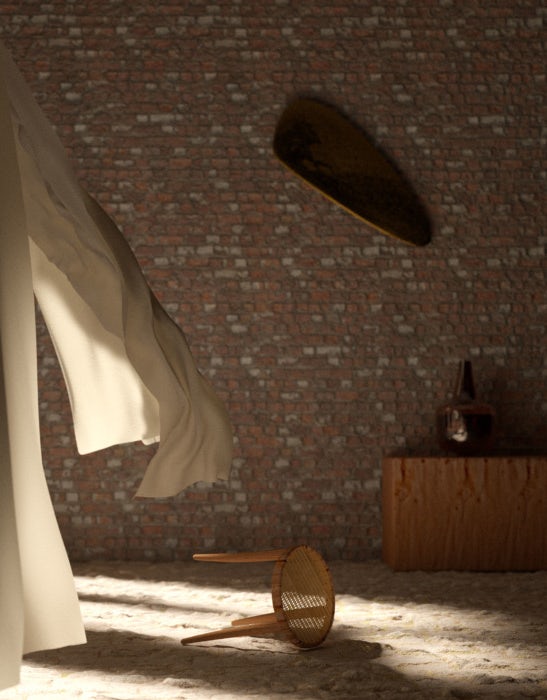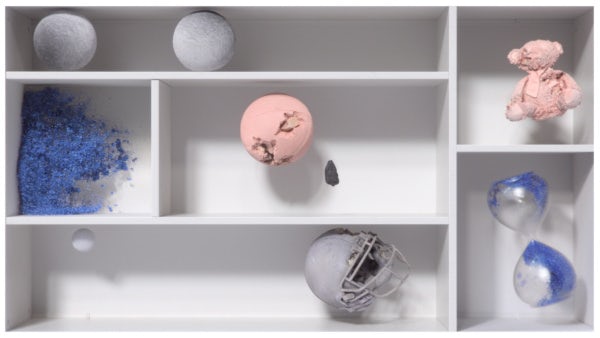99 Design For Animation 3d Model
When you're looking at a photo that just looks a little bit too perfect, or a little bit beyond the range of normal—an object or a landscape that's in uncanny valley—there's a chance you're not looking at a photo at all. You could be looking at a hyper-realistic 3D design like the ones Willem Stapel creates. That's not to say 3D designers can't create images that are indistinguishable from photographs, they can, but the magic of 3D design is the ability to push images beyond the realistic and onto a new, magical plane.

To say we're impressed with Stapel's work would be an understatement. We're huge fans, and when we recently got the chance to pick his brain about 3D design and his creative process, we ran with it.
Stapel got his start in 3D design while he was a graphic design student at Hogeschool voor de Kunsten in Utrecht, Netherlands. He began by playing around with 3D modeling software and says that's all anybody with an interest in 3D design has to do to get started. It's not the only way to learn 3D design, though. Colleges and universities all over the world offer courses in this type of design and for the less matriculation-minded, there are countless online tutorials that explain beginner and advanced techniques.
So what is 3D design all about and where is it headed? Keep reading to find out.
3D design explained
—

So we're on the same page, here's the quick and dirty on 3D design:
You've seen Toy Story and other Pixar films. Those were made with 3D modeling software. 3D modeling software is the type of program that makes it possible for a designer to craft complex, detailed three-dimensional digital objects and worlds for them to inhabit. Images created with this type of software can be as realistic or as cartoony as the designer desires. For a more realistic film example of 3D modeling in action, think of Avatar.
The software provides a simulated 3D space where the designer can create objects by plugging coordinates into the program and then manipulating the shapes their coordinates create. If this sounds like geometry class to you, that's because it kinda is—3D modeling is a blend of geometry and design visually represent the images specific coordinates map out. Often, designs start as basic polygons that designers refine into complex shapes using the tools available in their chosen software, like tools that create spline curves and tools for crafting non-rational b-splines (NURBS).
Different 3D modeling programs offer different tools, and some are better suited to designers with specific styles and design applications than others. According to Stapel, "CAD is usually used for things that are more industrial, like architectural or industrial designs. 3D meshes are usually a bit more free form, but can also be something very technical."
A few popular 3D modeling programs include:
- AutoCad
- Blender
- SketchUp
- Zbrush
Stapel's program of choice is Cinema 4D supplemented with a few plug-ins and side programs.
"3D design is still in an experimental space"
—

Which means anything is possible. In his work, Stapel plays with bold colors and lighting choices while incorporating inspiration he finds in classical compositions and ancient art themes.
Right now, 3D design is more popular in commercial art than you probably realize. Car companies use 3D modeling in commercials regularly because it's cheaper, easier, and when a commercial calls for extreme driving, safer than having an actual driver model the car's capabilities.
"It could eventually replace a lot of photography, which it is already starting to do," Stapel says. "If you look around in commercial and artistic fields there's loads of 3D work cropping up."
You'll notice a lot of Stapel's work involves furniture designs. Functionality is one of the hallmarks of 3D design: you can use it to render models of products in development and hash out ideas to see how a piece can work in a space. Also, one common practical use for 3D modeling is studying car accidents by recreating them in digital worlds.
Where is 3D design headed?
—

People want to realize hyperrealistic aesthetics. To create impossible sceneries and make them reality.
Stapel predicts a big change coming as more and more people discover what you can do with 3D design. "The first tendency of everyone in the art space seemed to be gimmicky 'post-internet' imagery but now you see that people want to realize hyperrealistic aesthetics. To create impossible sceneries and make them reality. Trends I personally really enjoy are photorealism in extreme ways, more complex implementation of 3D scanning techniques, and applying these innovative techniques in new ways and contexts," he says.
There's a huge element of functionality that transcends the 'design' appeal. 3D design can be used to actually make things, to create things efficiently that in the past might have been difficult to create.

Probably one of the coolest ways people are using 3D design is using it to make things, like how designer and inventor Markus Kayser created a solar-powered 3D printer that can turn desert sand into glass objects. Functional 3D design has applications in many different fields, and as Stapel says, "beyond having a place in the arts, there's application to the health sector, industrially, and hopefully for environmental purposes eventually." Exciting things lie ahead in the world of 3D design.
Finding inspiration for 3D design
—

Although having formal design training never hurts, Stapel explains that he doesn't think it's a necessity for a successful 3D designer. What matters is to follow inspiration and to develop a vision. "Some people focus intensely on the technique and are extremely talented in that aspect, while others specialize in the making of a picture as expression of their artistry. I have a graphic design background and was interested in the history of the arts, which I wanted to combine and translate through contemporary techniques," he says.
Personally, Stapel looks to classical designs for inspiration for his work. "I enjoy the themes being used since they're always ancient stories, narratives, and themes which really lend themselves to contemporary reimagination. On a granular level, there's something to the color schemes, the classical compositions, lighting, the materials".
I enjoy making sceneries that look like someone has just been there.
"I started with 3D by making imagery inspired by themes in ancient art, all reinvisioned with the help of 3D scans and 3D objects. This is still a big influence on my work. I enjoy making sceneries that look like someone has just been there. To also add the things that makes something real, the stains on a glass or a little rust on metal."
Lately, Stapel's been riffing on a post-human vibe in his work. By combining modernistic buildings with more classic designs and robotic objects, he creates surrealistic images.
Professionally, he aims for simplicity. You'll see this in his website—the images define his brand and make it easy to know immediately what the viewer's in for. As he sums it up, "let the aesthetic of the work speak for itself and translate into a visual identity."

Even a successful designer like Stapel has industry heroes they look toward and aspire to be more like. When we asked him who he looks up to, he responded, "there's a couple of established companies and agencies who create beautiful commercial stuff like ManvsMachine (London & Los Angeles), Builder's Club (London), and CATK (Berlin). I'm quite a big fan of the work of Frederik Heyman, whose work is a sort of post-apocalyptic renaissance by animating stills captures from 3D scanning."
Stapel strives to strike a balance between his commercial work and his personal art. "I have more ideas than I have time to execute," he says, "but it's important to me to continue developing as an artist."
How designers can get started in this field
—
Like Stapel said, all you really have to do to get started with 3D design is get on a computer and start playing around with rendering software. But playing around will only take you so far. 3D design has a bit of a steep learning curve, and to those who are serious about becoming 3D designers, Stapel recommends the following:

"There's a lot to be found on Youtube, or if you have a certain problem there's always Google, as obvious as that seems. I think I started out with the tutorials from greyscalegorilla, who teach a lot about the basics of the program. There's also amazing tutorials from the ENTAGMA, but those are all for Houdini, which is a more advanced 3D software."
Achieving professional success as a 3D designer
—
Getting good at design is only one part of becoming a professional success. The other half is finding clients who'll pay a fair price for your work and maintaining a steady workflow.
According to Stapel, a designer's portfolio is key to landing and securing work: "In art school you learn not only to discover but also to develop your own style into something that works commercially and artistically. It's subtle things like color palettes, lighting and mood, use of material, et cetera. It takes work to get work, and I'm lucky to have people approach me because of the portfolio I've built for myself. It's a huge advantage to work with clients who are drawn to your established style, so emphasis on the portfolio is key."
Technique is part, but not all, of building a strong portfolio. "I think figuring out what technique works best for you without being a slave to the technique. Let the technique work for you. But that's true outside of design: painting with perfect technique doesn't necessarily make you a good artist."
Whether it's worthwhile to do unpaid work for exposure is a controversial topic among creatives. For Stapel, it paid off. "I started to get commercial jobs because of the unpaid or autonomous work I already did. The commercial work gave me more insight on techniques and certain new-to-me aspects on how to create something beautiful, really broadening my horizon."
Living and working as a 3D designer
—
Becoming a freelance 3D designer may be a challenge, but it offers amazing opportunities. "I love working with a broad variety of people, being able to create things that I love, and being my own boss," Stapel says, reflecting on the freedom he has to travel and work from anywhere as a freelancer and the variety of clients he's exposed to in this position. "It's a wonderful life, to be honest."
3D design is everywhere, and as a 3D designer, Stapel works primarily with photographers. As for the industries he's designed for, everything goes. 3D design can be as technical or as freeform as a designer needs it to be.
Discover the magic of 3D design
—
What Stapel wishes more people understood about 3D design is how satisfying it can be for a creator. "It's honestly pretty magical," he says. "Every time I push the render button it's a bit of a surprise what will come out. It's extremely satisfying to create something that looks really realistic but is completely fabricated."
The world of 3D design holds vast potential for designers and brands alike. Whether it's hyperrealistic objects or surreal landscapes, anything is possible. What will you do with it?
Want to see more amazing 3D designs by professional designers?
Right this way.
99 Design For Animation 3d Model
Source: https://99designs.com/blog/design-history-movements/3d-design/
Posted by: biermannoccowell.blogspot.com

0 Response to "99 Design For Animation 3d Model"
Post a Comment